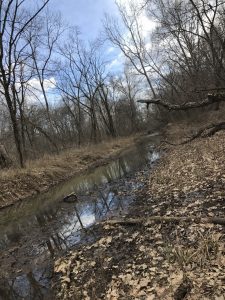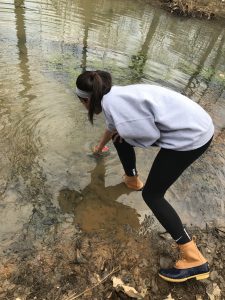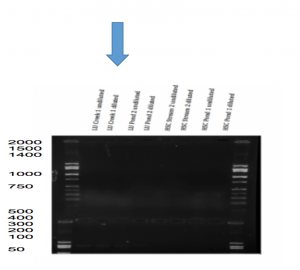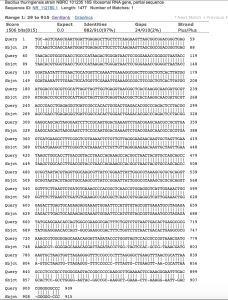Bacillus thuringiensis is an off-white, cream colored bacteria that was in the soil of Buffalo Creek. The bacteria was previously found in the German state of Thuringia where it’s name originated. It is mostly used to control insect infestation in agriculture fields (Mohamed, 2010).
Reference:
Mohamed IA, Griko N, Junker M, Bulla LA. 2010. Bacillus thuringiensis: A genomics and proteomics perspective. Bioeng Bugs; 1(1): 31-50.
Data collected: February 8, 2017
Methods for Isolation and Identifications:
- 50ml of soil was collected from Buffalo Creek where the water was flowing and not still (Figure 1). The sample was mixed with 10ml of sterile water. It streaked onto a nutrient rich agar plate.
- The off-white, creamy colored colony was chosen for gene sequencing by PCR amplification (Figure 2).
Figure 1: Site of Collection (Buffalo Creek)


Figure 2: Colony selected for Identification
 Results:
Results:
- PCR Amplification & Msp1 digestion (Figure 3) The PCR experiment led to a 1,500 bp product. Our gels were hard to read, therefore we cannot be certain to the number of bands. Figure 3 shows an arrow to the sample where this bacteria came from.

Figure 3. The Gel Electrophoresis showing the PCR amplification and Msp1 digestion.
- Sequence analysis (Figure 4): The sequenced PCR product generated 910 bases that we used to further identify our bacteria. The chromatogram of the sequence is available as a pdf (TGCELC2_PREMIX_JF7570_38). NCBI BLAST analysis revealed 99% identity with bases 29-915 of the 16s rRNA gene of Bacillus thuringiensis (Figure 4).

Figure 4: NCBI BLAST analysis of Strain NBRC 101235
Contributed by: Cecilie Elliott and Tatianna Griffen, BIOL 250 Spring 2017